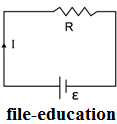OHM'S
LAW
Probably the most important mathematical
relationship between voltage, current and resistance in electricity
is something called “Ohm’s Law”. A man named George
Ohm published this formula in 1827 based on his experiments with
electricity. This formula is used to calculate electrical values
so that we can design circuits and use electricity in a useful
manner. Ohm's Law is shown below.
|
OHM'S LAW
I
= V/R,
I = current,
V = voltage, and R =
resistance
*Depending on
what you are trying to solve we can rearrange it two other
ways.
V
= I x R
R = V/I
*All of these
variations of Ohm’s Law are mathematically equal to
one another.
|
Let’s look at what Ohm’s
Law tells us. In the first version of the formula, I =
V/R, Ohm's
Law tells us that the electrical current in a circuit
can be calculated by dividing the voltage by the
resistance. In other words, the current is directly proportional to the
voltage and inversely proportional
to the resistance. So, an increase in the voltage
will increase the current as long as the resistance is
held constant. Alternately, if the resistance
in a circuit is increased and the voltage does not
change, the current will decrease.
The second version of the
formula
tells us that the voltage can be calculated if the
current and the resistance in a circuit are known. It can be seen from
the equation that if either the current or the resistance is increased
in the circuit (while the other is unchanged), the voltage
will also have to increase.
The third
version of the formula tells us that we can calculate the
resistance in a circuit if the voltage and current are known. If the
current is held constant, an increase in voltage will
result in an increase in resistance. Alternately, an
increase in current
while holding the voltage constant will result in a
decrease in resistance. It should be noted that Ohm's law holds true for
semiconductors, but for a wide variety of materials (such as metals)
the resistance is fixed and does
not depend on the amount of current or the amount of voltage.
As you can see, voltage, current,
and resistance are mathematically, as well as, physically related
to each other. We cannot deal with electricity without all three
of these properties being considered.
Example of question :
Example of question :
1. A simple electrical circuit consisting of a
battery as a power source voltage ε and
a load resistor R.

If ε is 12 volts and R is 3
Ω specify:
a) strong current flowing
b) the amount of charge that flows in 1 minute
a) strong current flowing
b) the amount of charge that flows in 1 minute
Solution :
a) strong current flowing
For a simple circuit as above just use:
I = ε / R
I = 12/3
I = 4 A
b) the amount of charge that flows in 1 minute
Q = I x t
A Q = 4 x 60 sec
Q = 240 Coulomb
2. A direct current electrical circuit consists of a 12 volt battery, and three resistance, respectively:
R1 = 40
Ω
R2 = 60 Ω
R3 = 6 Ω
R2 = 60 Ω
R3 = 6 Ω

Define:
a) The total resistance in the circuit
b) Strong circuit current (I)
c) a strong current in the resistance R1
d) a strong current in the resistance R2
e) whether Itotal, I1 and I2 satisfy Kirchhoff's current law?
a) The total resistance in the circuit
b) Strong circuit current (I)
c) a strong current in the resistance R1
d) a strong current in the resistance R2
e) whether Itotal, I1 and I2 satisfy Kirchhoff's current law?
a) Rtotal = R1 + R2 + R3
1/Rp = 1/40 = 1/60 = 5/120
Rp = 24
Rtotal = 6Ω + 24Ω = 30Ω
b) Strong circuit current
I = 12 volt / 30 Ω
I = 0.4 A
c) a strong current in the resistance R1
I1 = Itotal x (R2 / (R1 + R2)
I1 = 0.4 x (60 / (40 + 60)
I1 = 0.4 x (60 / (100) = 0.24 A
d) a strong current in the resistance R2 I2 = Itotal x (R1 / (R1 + R2) I2 = 0.4 x (40 / (40 + 60)
I2 = 0.4 x (40 / (100) = 0.16 A
e) whether Itotal, I1 and I2 satisfy Kirchhoff's current law?
According to Kirchhoff's current law,
ΣImasuk = ΣIkeluar
So the number of I1 and I2 be the same as Itotal = 0.4 A
Itotal = I1 + I2
Itotal = 0.24 + 0.16 = 0.40 A, according to the results of the calculation point b above.
1/Rp = 1/40 = 1/60 = 5/120
Rp = 24
Rtotal = 6Ω + 24Ω = 30Ω
b) Strong circuit current
I = 12 volt / 30 Ω
I = 0.4 A
c) a strong current in the resistance R1
I1 = Itotal x (R2 / (R1 + R2)
I1 = 0.4 x (60 / (40 + 60)
I1 = 0.4 x (60 / (100) = 0.24 A
d) a strong current in the resistance R2 I2 = Itotal x (R1 / (R1 + R2) I2 = 0.4 x (40 / (40 + 60)
I2 = 0.4 x (40 / (100) = 0.16 A
e) whether Itotal, I1 and I2 satisfy Kirchhoff's current law?
According to Kirchhoff's current law,
ΣImasuk = ΣIkeluar
So the number of I1 and I2 be the same as Itotal = 0.4 A
Itotal = I1 + I2
Itotal = 0.24 + 0.16 = 0.40 A, according to the results of the calculation point b above.
ok cintyia, in your explanation only talk about ohms law, but in example there are quantity "Q", can you explain it?
BalasHapusgood night cintya,
BalasHapuswho is the large influence between the series or parallel resistance circuit in an electrical circuit?